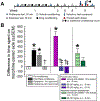An analog of [d-Trp]CJ-15,208 exhibits kappa opioid receptor antagonism following oral administration and prevents stress-induced reinstatement of extinguished morphine conditioned place preference
- PMID: 35584724
- PMCID: PMC11891885
- DOI: 10.1016/j.pbb.2022.173405
An analog of [d-Trp]CJ-15,208 exhibits kappa opioid receptor antagonism following oral administration and prevents stress-induced reinstatement of extinguished morphine conditioned place preference
Abstract
Opioid use disorder (OUD) relapse rates are discouragingly high, underscoring the need for new treatment options. The macrocyclic tetrapeptide natural product CJ-15,208 and its stereoisomer [d-Trp]CJ-15,208 demonstrate kappa opioid receptor (KOR) antagonist activity upon oral administration which prevents stress-induced reinstatement of cocaine-seeking behavior. In order to further explore the structure-activity relationships and expand the potential therapeutic applications of KOR antagonism for the treatment of OUD, we screened a series of 24 analogs of [d-Trp]CJ-15,208 with the goal of enhancing KOR antagonist activity. From this screening, analog 22 arose as a compound of interest, demonstrating dose-dependent KOR antagonism after central and oral administration lasting at least 2.5 h. In further oral testing, analog 22 lacked respiratory, locomotor, or reinforcing effects, consistent with the absence of opioid agonism. Pretreatment with analog 22 (30 mg/kg, p.o.) prevented stress-induced reinstatement of extinguished morphine conditioned place preference and reduced some signs of naloxone-precipitated withdrawal in mice physically dependent on morphine. Collectively, these data support the therapeutic potential of KOR antagonists to support abstinence in OUD and ameliorate opioid withdrawal.
Keywords: Antagonist; Kappa opioid receptor; Macrocyclic peptide; Opioid use disorder; Reinstatement; Withdrawal.
Copyright © 2022 Elsevier Inc. All rights reserved.
Figures








Similar articles
-
Novel opioid cyclic tetrapeptides: Trp isomers of CJ-15,208 exhibit distinct opioid receptor agonism and short-acting κ opioid receptor antagonism.Br J Pharmacol. 2012 Feb;165(4b):1097-108. doi: 10.1111/j.1476-5381.2011.01544.x. Br J Pharmacol. 2012. PMID: 21671905 Free PMC article.
-
The macrocyclic tetrapeptide [D-Trp]CJ-15,208 produces short-acting κ opioid receptor antagonism in the CNS after oral administration.Br J Pharmacol. 2013 May;169(2):426-36. doi: 10.1111/bph.12132. Br J Pharmacol. 2013. PMID: 23425081 Free PMC article.
-
Multifunctional opioid receptor agonism and antagonism by a novel macrocyclic tetrapeptide prevents reinstatement of morphine-seeking behaviour.Br J Pharmacol. 2020 Sep;177(18):4209-4222. doi: 10.1111/bph.15165. Epub 2020 Jul 16. Br J Pharmacol. 2020. PMID: 32562259 Free PMC article.
-
Tryptophan Substitution in CJ-15,208 (cyclo[Phe-D-Pro-Phe-Trp]) Introduces δ-Opioid Receptor Antagonism, Preventing Antinociceptive Tolerance and Stress-Induced Reinstatement of Extinguished Cocaine-Conditioned Place Preference.Pharmaceuticals (Basel). 2023 Aug 29;16(9):1218. doi: 10.3390/ph16091218. Pharmaceuticals (Basel). 2023. PMID: 37765026 Free PMC article.
-
Peptide Kappa Opioid Receptor Ligands and Their Potential for Drug Development.Handb Exp Pharmacol. 2022;271:197-220. doi: 10.1007/164_2021_519. Handb Exp Pharmacol. 2022. PMID: 34463847 Review.
Cited by
-
A review of the kappa opioid receptor system in opioid use.Neurosci Biobehav Rev. 2024 Jul;162:105713. doi: 10.1016/j.neubiorev.2024.105713. Epub 2024 May 10. Neurosci Biobehav Rev. 2024. PMID: 38733895 Free PMC article.
References
-
- Aldrich JV, Senadheera SN, Ross NC, Reilley KA, Ganno ML, Eans SE, Murray TF, McLaughlin JP, 2014. Alanine analogues of [D-Trp]CJ-15,208: novel opioid activity profiles and prevention of drug- and stress-induced reinstatement of cocaine-seeking behaviour. Br. J. Pharmacol 171 (13), 3212–3222. 10.1111/bph.12664. - DOI - PMC - PubMed
Publication types
MeSH terms
Substances
Grants and funding
LinkOut - more resources
Full Text Sources

